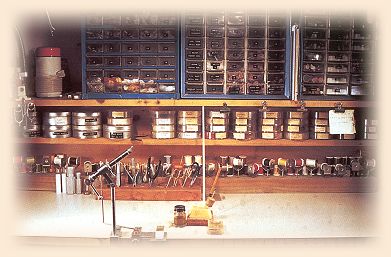Reviewed by Stu Farnham
A.K. Best's latest book was one of the most anticipated books
on fly tying to come out in recent years. The anticipation
was due in part to A.K.'s reputation, and in part to delays
in publication when the publisher, Lyons Press, was acquired
by Globe Pequot. Originally expected in November 2001, the
book finally made its way to release and to my collection in
March 2002.
 A.K. was first introduced to most of us via the writing of John
Gierach, who is a close friend of A.K.'s and who contributed the
introduction to this volume and to A.K.'s other books. A.K.'s
previous books include Production Fly Tying (1989),
Dyeing and Bleaching Natural Fly-Tying Materials (1993),
and A.K.'s Fly Box (1996).
A.K. was first introduced to most of us via the writing of John
Gierach, who is a close friend of A.K.'s and who contributed the
introduction to this volume and to A.K.'s other books. A.K.'s
previous books include Production Fly Tying (1989),
Dyeing and Bleaching Natural Fly-Tying Materials (1993),
and A.K.'s Fly Box (1996).
Fly tying is a craft based in its minutiae, and A.K. has accumulated
a wealth of detailed experience which he shares in these books.
Refreshingly, he is not afraid to admit to subjectivity, discussing
his likes and dislikes, and acknowledging that, while these books
reflect his methods and preferences, other valid points of view
exist.
The latest volume covers topics not normally discussed in fly
tying books. The first chapter covers vise and tool care, with
emphasis on a periodic tune up for your vise. While the
instructions are specific to a draw collet style of vise,
you can readily adapt them for your own vise of choice.
Chapter two speaks specifically, although briefly, about
the uses and virtues of rotary vises, as well as making
the transition to rotary tying. Like every other change,
this one takes a little while to get through, but, in A.K.'s
opinion (and mine) is worth the effort.
Next come techniques for saving time - not for tying fast,
but rather for tying efficiently. There are almost 30
different tips, ranging from keeping your scissors in hand
through organization of materials and ergonomics of your
work area to, in his final recommendation, tying at least
one fly every day.

The fourth chapter covers hand position, a topic I have seldom
seen addressed, presenting some general principles and providing
photographs of correct hand position when applying various
materials.
Despite the increasing popularity of hackle-less designs and
the increasing cost of quality hackle, hackle and hackling
techniques remain fundamental to our craft. There are three
chapters on the subject: 'Necks or Saddles' provides answers
for a question that is often asked by novice and intermediate
tiers. 'Hackle Sizing' gives A.K.'s views on this topic, which
don't quite fit conventional wisdom, and 'Avoiding Cone Shaped
Hackle Collars' covers his method for hackling dry flies, which
is valuable to those who have not read his earlier books.
Following a chapter on tying heads (an often neglected but vital
topic) comes another gem. 'Tying Yourself Out of Trouble' offers
a collection of hints, tips, and tricks for recovering from
those mini-disasters which we all encounter halfway through
tying a fly: broken thread, broken hackle stems, cracked quills,
and more.
The longest chapter in the book, at 64 pages, is a collection
of fly patterns, tying techniques, and fishing advice called
'Delicate Flies for Skinny Water.' A.K. is a tier who believes
that the devil is in the details, and his variations on typical
patterns (such as his protruding wing tips for beetles) provide
interesting insights. All other the patterns are accompanied
by clear, detailed color photographs.
Chapters on spun deer hair on small hooks, indestructible biot
bodies, several chapters on specific favorite patterns, and
advice on field modifications to your flies and the contents
of a traveler's tying kit round out the book.
All in all, this is another fine effort, well written, clear,
and detailed. Whether you agree with A.K.'s preferences, you'll
find his point of view interesting and undoubtedly learn a few
tricks that will make you a better tier.
My only complaint is that this, at $40 retail, is a rather slim
volume, and shares a lot with A.K.'s previous tying books. All
three could have been combined into a single volume, with less
repetition that would make a heck of a manual for advanced tiers.
However, if he did that, we wouldn't have had the delightful
anticipation of the publication of the next installment.
~ SF
Advanced Fly Tying: The Proven Methods and Techniques of a Master Professional Fly Tyer
234 pages
7" x 9"
Hardcover $40.00 U.S.
ISBN 1-58574-339-9
Published by
The Lyons Press
Previous Reviews
|


 A.K. was first introduced to most of us via the writing of John
Gierach, who is a close friend of A.K.'s and who contributed the
introduction to this volume and to A.K.'s other books. A.K.'s
previous books include Production Fly Tying (1989),
Dyeing and Bleaching Natural Fly-Tying Materials (1993),
and A.K.'s Fly Box (1996).
A.K. was first introduced to most of us via the writing of John
Gierach, who is a close friend of A.K.'s and who contributed the
introduction to this volume and to A.K.'s other books. A.K.'s
previous books include Production Fly Tying (1989),
Dyeing and Bleaching Natural Fly-Tying Materials (1993),
and A.K.'s Fly Box (1996).